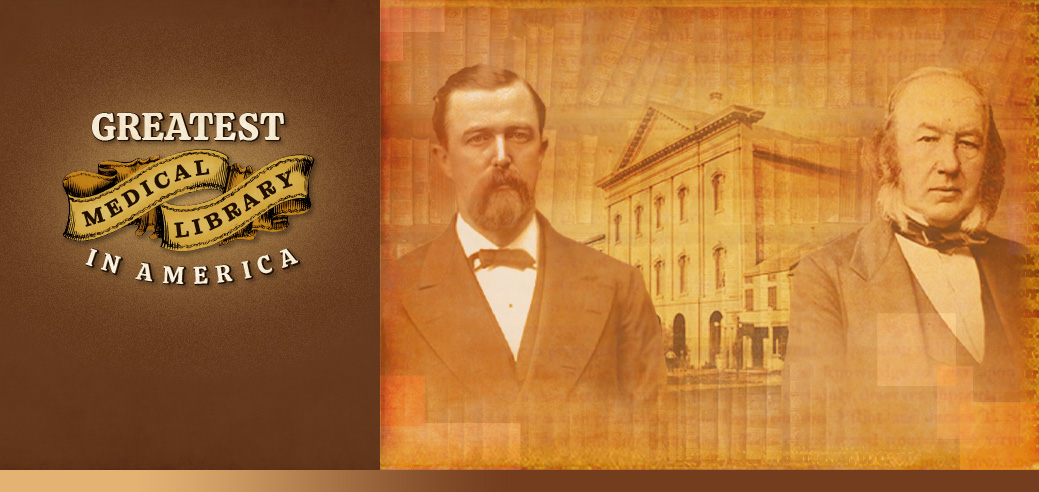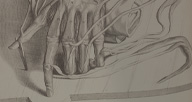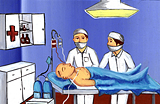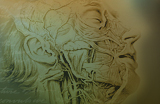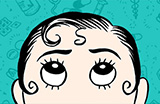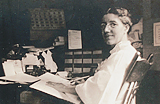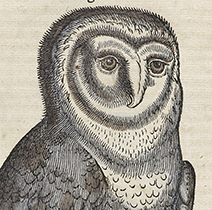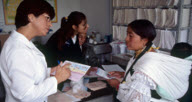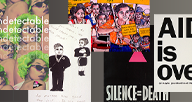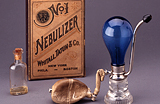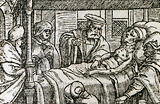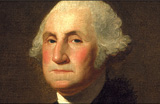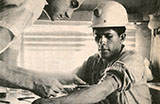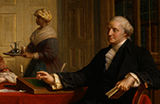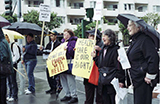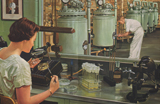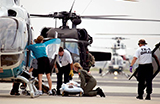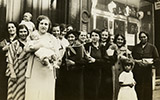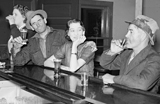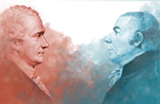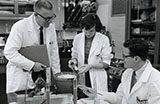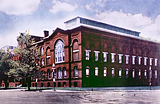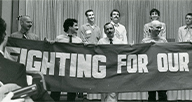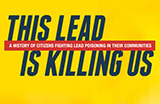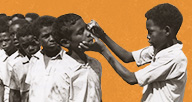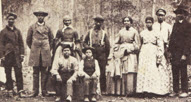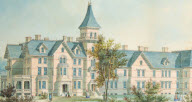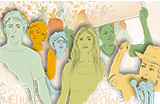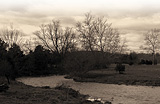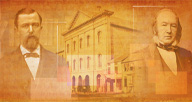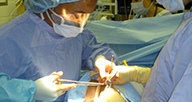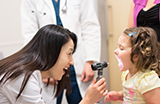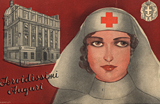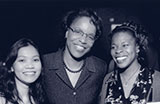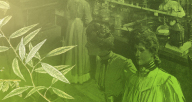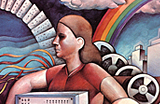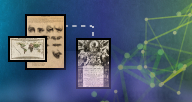Making the Greatest Medical Library in America showcases a selection of 19th century medical pamphlets featured in the National Library of Medicine’s first reported exhibition in 1878 and explores the institution’s long history of collecting, cataloging, and communicating quality medical information.
Discover NLM Exhibitions
NLM exhibitions feature stories about history, society, and medicine drawn from the world-renowned collections of the NLM. Topics include history of lead poisoning in America, the yellow fever epidemic in 1793 in Philadelphia, African American surgeons, the history of women physicians, among others. Discover something new about the past!
Open All-
-
“And there’s the humor of it!”: Shakespeare and the four humors
English poet and playwright William Shakespeare created characters that are among the richest and most humanly recognizable in all of literature. Yet Shakespeare understood human personality and health in the terms available to his age—that of the now-discarded theory of the four bodily humors—blood, yellow bile, black bile, and phlegm. "And there's the humor of it": Shakespeare and the four humors explores the language of the four humors and their influence in Shakespeare’s plays.
VIEW Online Exhibition – Digital Gallery – Resources | Traveling Exhibition
-
Dream Anatomy
The invention of the printing press in the 15th century—and the print technologies that followed—helped to inspire the science of anatomy, and new visions of the body. In turn, anatomical imagery proliferated, both detailed and informative, but also whimsical, surreal, beautiful, and grotesque—a dream anatomy that reveals as much about the outer world as it does the inner self. Dream Anatomy shows off the anatomical imagination from 1500 to the present.
VIEW Online Exhibition – Digital Gallery – Resources
-
Everyday Miracles: Medical Imagery in Ex–Votos
Ex-votos, devotional paintings giving thanks to a saint or deity, are a reflection of a tradition where faith and healing play a vital role in daily life. Everyday Miracles: Medical Imagery in Ex-Votos explores this tradition that began in Italy during the 1400s, spread to the New World a century later, and is still active today.
VIEW Online Exhibition
-
Frankenstein: Penetrating the Secrets of Nature
In 1816, Mary Shelley conceived a story about a scientist who creates a creature that can think and feel, but is monstrous to the eye. Spurned by all, the embittered creature turns into a savage killer. Shelley’s story served as a metaphor for apprehensions about scientific advancement that continue to resonate today. Frankenstein: Penetrating the Secrets of Nature explores the power of this story to expose hidden fears of science and technology as human efforts to penetrate the secrets of nature continue.
VIEW Online Exhibition – Digital Gallery – Class Resources | Traveling Exhibition (English) | Traveling Exhibition (English and Spanish)
-
Graphic Medicine: Ill-Conceived and Well-Drawn!
People have told stories of illness from the perspective of their personal experiences using many mediums. The art of comics, which combines words and pictures, gives approachability and emotional impact to these personal stories, and even to the clinical data they sometimes include. Graphic Medicine: Ill-Conceived and Well-Drawn! explores the meaning of an emerging sub-genre of medical literature that combines the art of comics and the personal illness narrative.
VIEW Online Exhibition – Class Resources | Traveling Exhibition
-
The Literature of Prescription: Charlotte Perkins Gilman and "The Yellow Wall-Paper"
During a time when women were challenging traditional ideas about gender that excluded them from political and intellectual life, artist and writer Charlotte Perkins Gilman rejected these ideas in a terrifying short story titled "The Yellow Wall-Paper.” The Literature of Prescription: Charlotte Perkins Gilman and “The Yellow Wall-Paper” explores the story behind Gilman’s indictment of the medical profession and the social conventions restricting women’s professional and creative opportunities.
VIEW Online Exhibition – Class Resources | Traveling Exhibition
-
Renaissance Science, Magic, and Medicine in Harry Potter's World
In 1997, British author J. K. Rowling introduced the world to Harry Potter. Since then, millions of readers have followed Harry’s story. The magic in the Harry Potter novels is based partially on Renaissance traditions that played an important role in the development of Western science, including alchemy, astrology, and natural philosophy. Renaissance Science, Magic, and Medicine in Harry Potter's World explores the intersection of these worlds in the NLM’s History of Medicine collection.
VIEW Online Exhibition – Digital Gallery – Class Resources | Traveling Exhibition
-
-
-
Against the Odds: Making a Difference in Global Health
A revolution in global health is taking place in villages and towns around the world. Communities, in collaboration with scientists, advocates, governments, and international organizations, are taking up the challenge to prevent disease and improve quality of life. Against the Odds: Making a Difference in Global Health examines stories of the people who are working on a wide range of issues around the world—from community health to conflict and disease to discrimination.
VIEW Online Exhibition – Class Resources
-
AIDS Posters and Stories of Public Health: A People's History of a Pandemic
The collection of HIV/AIDS ephemera at the NLM is rooted in the cultural output of artists, activists, and community workers who use personal narrative, drawing as a visual art strategy, language, and the collective process to create posters that deliver vital health messages. AIDS Posters and Stories of Public Health: A People's History of a Pandemic looks at visual materials that have spurred communities into action and continue to broadcast the message that AIDS is not over.
VIEW Online Exhibition – Resources | Traveling Exhibition
-
Breath of Life
Throughout history, people everywhere in every age have struggled with asthma. Today, asthma is a serious, widespread problem affecting millions of people in the United States. But what is asthma? Who has asthma and why? Have its prevalence and impact grown dramatically in our time? Can it be managed, prevented, or cured? How do people cope with asthma? To search for answers, Breath of Life examines the medical and human history of asthma.
VIEW Online Exhibition
-
Emotions and Disease
For centuries, physicians and non-physicians alike have acknowledged that the way people feel in their minds can influence the way they respond in their bodies. A recent field of research is exploring the connections between the neuroendocrine and immune systems—the influence of emotions on the onset, course, and remission of disease. Emotions and Disease highlights moments of this historical journey toward understanding how mental state impacts physical health, as it leads into the promising future.
VIEW Online Exhibition
-
Every Necessary Care and Attention: George Washington & Medicine
George Washington had many different concerns and responsibilities, from running his plantation to ensuring the stability of a new nation. His status and wealth gave him—and his community—access to a growing class of medical experts and new knowledge about the spread and prevention of disease. Even so, Washington encountered the limits of medicine when faced with serious illness. Every Necessary Care and Attention: George Washington and Medicine examines the ways in which Washington sought to ensure the health and safety of his family, staff, enslaved workers, and troop.
VIEW Online Exhibition – Digital Gallery – Class Resources | Traveling Exhibition
-
Fifty Years Ago: The Darkening Day
In 1970, the National Library of Medicine featured an exhibition about environmental pollution called The Darkening Day. As the modern environmental movement gained traction in the years prior, the public learned more about the harms of pollution, while scientists and government agencies worked to limit its effects. Fifty Years Ago: The Darkening Day highlights items from the NLM collections that represent government and scientific efforts to learn about and address environmental pollution’s health impacts in the 1940s through the 1960s.
VIEW Online Exhibition
-
Fire and Freedom: Food and Enslavement in Early America
Meals can tell us how power is exchanged between and among different peoples, races, genders, and classes. In the Chesapeake region during the colonial era, European settlers relied upon indentured servants, Native Americans, and African slave labor for life-saving knowledge of farming and food acquisition, and to gain economic prosperity. Fire and Freedom: Food and Enslavement in Early America peers into life at George Washington’s Mount Vernon plantation and the labor of enslaved workers to learn about the ways that meals transcend taste and sustenance.
VIEW Online Exhibition – Digital Gallery – Class Resources | Traveling Exhibition
-
For All the People: A Century of Citizen Action in Health Care Reform
Often, the public associates health care reform with presidents and national leaders, but communities, workers, activists, and health care professionals have made their voices heard in the debate about whether and how to make quality health care available to all. For All the People: A Century of Citizen Action in Health Care Reform tells the lesser-known story of how movements of ordinary citizens helped shape the changing American health care system.
VIEW Online Exhibition – Digital Gallery – Class Resources | Traveling Exhibition (English) | Traveling Exhibition (English and Spanish)
-
From DNA To Beer: Harnessing Nature in Medicine and Industry
Over the past two centuries, scientists, in partnership with industry, have developed techniques using and modifying life forms like yeast, molds, and bacteria, to create a host of new therapies and produce better foods and beverages. From DNA to Beer: Harnessing Nature in Medicine and Industry explores some of the processes, problems, and potential inherent in technologies that use microorganisms for health and commercial purposes.
VIEW Online Exhibition – Digital Gallery – Class Resources | Traveling Exhibition
-
Making a World of Difference: Stories About Global Health
Communities, researchers, and medical professionals around the globe are mobilizing to prevent disease and improve quality of life. They work on projects that increase access to primary health care, reduce discrimination, address health information needs, foster medical discoveries through research, help end conflict, and provide vital care during natural disasters. Making a World of Difference: Stories About Global Health examines people's efforts to improve health in their communities and around the world.
VIEW Online Exhibition – Digital Gallery – Class Resources | Traveling Exhibition
-
Outside/Inside: Immigration, Migration, and Health Care in the United States
Immigration and migration are important parts of the American story and health care and medicine have played a role in inclusion and exclusion, in “assimilation” and discrimination, in dividing communities and strengthening them. Outside/Inside: Immigration, Migration, and Health Care in the United States explores immigrant and migrant health since the late 1800s.
VIEW Online Exhibition – Digital Gallery – Class Resources | Traveling Exhibition
-
Pick Your Poison: Intoxicating Pleasures & Medical Prescriptions
Throughout the history of America, people have used mind altering drugs. While some of those drugs are socially acceptable, others are outlawed because of their toxic, and intoxicating, characteristics. These classifications have shifted at different times in history, and will continue to change. Pick Your Poison: Intoxicating Pleasures and Medical Prescriptions explores the factors that have shaped the changing definitions of some of our most potent drugs, from medical miracle to social menace.
VIEW Online Exhibition – Digital Gallery – Class Resources | Traveling Exhibition
-
Politics of Yellow Fever in Alexander Hamilton’s America
In 1793, yellow fever ravaged Philadelphia. Citizens confronted the epidemic in the absence of an effective cure or consensus about the origins of the disease. Medical professionals, early political parties, and private citizens seized on the epidemic to advance their respective agendas. As a result, Philadelphia’s sick and dying received medical care informed as much by politics as by the best available science. Politics of Yellow Fever in Alexander Hamilton’s America considers how science and politics helped determine the response to the 1793 yellow fever epidemic in Philadelphia.
VIEW Online Exhibition – Digital Gallery – Class Resources | Traveling Exhibition
-
Rashes to Research: Scientists and Parents Confront the 1964 Rubella Epidemic
As the rubella epidemic raged in 1964, 20,000 children were born with serious heart, hearing, and vision problems related to rubella exposure during pregnancy. While the nation’s scientists rushed to create a vaccine and develop better screening tests, families faced difficult decisions about current and future pregnancies. Rashes to Research: Scientists and Parents Confront the 1964 Rubella Epidemic highlights the work of researchers and parents to respond to rubella in the years before an effective vaccine nearly eliminated the disease from the United States.
VIEW Online Exhibition – Digital Gallery – Class Resources | Traveling Exhibition
-
So, What's New in the Past? The Multiple Meanings of Medical History
The history of medicine tells different stories and different truths depending on the questions asked and the concerns raised. That’s why there is always something new in the past. History provides different meanings and different content to find answers to ever-changing questions. So, What’s New in the Past? The Multiple Meanings of Medical History explores some of the many meanings people have found in the history of medicine within the United States.
VIEW Online Exhibition
-
Surviving and Thriving: AIDS, Politics, and Culture/Sobrevivir y Prosperar: Sida, Política y Cultura
In 1981, a new disease appeared in the United States. Reactions to the disease, soon named AIDS (acquired immune deficiency syndrome), varied. Early responders cared for the sick, fought homophobia, and promoted new practices to keep people healthy. Scientists and public health officials struggled to understand the disease and how it spread. Politicians remained largely silent until the epidemic became too big to ignore. Activists demanded that people with AIDS be part of the solution. Surviving and Thriving: AIDS, Politics, and Culture/Sobrevivir y Prosperar: Sida, Política y Cultura, a bilingual exhibition in English and Spanish, illustrates an iconic history of AIDS alongside lesser-known examples of historical figures who changed the course of the pandemic.
VIEW Online Exhibition – Digital Gallery – Class Resource | Traveling Exhibition (English) | Traveling Exhibition (English and Spanish)
-
This Lead Is Killing Us: A History of Citizens Fighting Lead Poisoning in Their Communities
Lead exposure can cause neurological problems and sometimes even death; yet this metal has been pervasive in many aspects of American life for over a century. Many industries have included lead in their production processes and in products like household paints and gasoline, endangering health. This Lead Is Killing Us: A History of Citizens Fighting Lead Poisoning in Their Communities tells an important story of advocates protecting their communities from the dangers of lead and making their voices heard with industry, housing authorities, and elected officials.
VIEW Online Exhibition – Digital Gallery – Class Resources | Traveling Exhibition
-
A Voyage to Health
Around the year 400, migrating voyagers from the South Pacific began to settle on the island of Kaho‘olawe. For centuries, the island served as a navigational hub for the region and sacred site until European colonizers invaded. Following WWII, the United States military seized the island for bombing exercises. A Voyage to Health explores the history of Kaho‘olawe, traditional voyaging, and how the resurgence of Native Hawaiian culture has helped heal the community.
VIEW Online Exhibition – Class Resources
-
World Health Organization: Picturing Health for All
Since the 1950s, the World Health Organization, the authority on global public health, has commissioned accomplished photojournalists to capture the transformative impact of health campaigns on communities worldwide. World Health Organization: Picturing Health for All showcases a selection of these photographs drawn from the NLM collection.
VIEW Online Exhibition
-
-
-
Binding Wounds, Pushing Boundaries: African Americans in Civil War Medicine
During the American Civil War, African Americans overcame prejudices to serve as soldiers, nurses, surgeons, laundresses, cooks, and laborers. Their participation challenged the prescribed notions about race and gender and pushed the boundaries of Blacks’ role in America. Binding Wounds, Pushing Boundaries: African Americans in Civil War Medicine explores the stories of men and women who came from different backgrounds and life experiences, but whose desire to participate in the cause for freedom transcended class, education, and social position.
VIEW Online Exhibition – Class Resources | Traveling Exhibition
-
Care and Custody: Past Responses to Mental Health
Over the past 200 years in the United States, a tension has existed between care and custody as responses to mental health issues. The actions of physicians, psychiatric survivors, families, and government agencies have all shaped mental health policies. Care and Custody: Past Responses to Mental Health examines history to understand how the country has moved away from custodial forms of treatment, sought a more inclusive society, and worked to protect the rights of people with mental health conditions.
VIEW Online Exhibition – Digital Gallery – Class Resources | Traveling Exhibition
-
Changing the Face of Medicine: Celebrating America's Women Physicians
As mothers and grandmothers, women nursed the sick in their homes. As midwives, wise women, and curanderas, women cared for people in their communities. Yet, when medicine became a formal profession in Europe and America, women were shut out. Nevertheless, they fought to gain access to medical education and hospital training. Changing the Face of Medicine: Celebrating America’s Women Physicians acknowledges how women have created and broadened opportunities in medicine and introduces many extraordinary women who have studied and practiced medicine in America.
VIEW Online Exhibition – Class Resources
-
Confronting Violence: Improving Women’s Lives
Activists and reformers in the United States have long recognized the harm of domestic violence and sought to improve the lives of women who were battered. Beginning in the late 1970s, nurses were in the vanguard as they pushed the larger medical community to identify victims, adequately respond to their needs, and work towards the prevention of domestic violence. Confronting Violence: Improving Women’s Lives explores these developments during latter half of the 20th century, when nurses took up the call.
VIEW Online Exhibition – Digital Gallery – Class Resources | Traveling Exhibition (English) | Traveling Exhibition (English and Spanish)
-
Healing the Nation: Stories From the Civil War
The National Library of Medicine commemorates the anniversary of the American Civil War with this collection of exhibitions and resources. Explore the online stories of the experiences of physicians, nurses, surgeons, and soldiers.
VIEW Online Exhibition
-
Life and Limb: The Toll of the American Civil War
Over three million soldiers fought in the American Civil War. More than half a million died and almost as many were wounded. Hundreds of thousands were permanently disabled by battlefield injuries or surgery, which saved lives by sacrificing limbs. These men remained a stark reminder of the costs of the conflict for long after the war. Life and Limb: The Toll of the American Civil War explores experiences of disabled veterans and their role as symbols of the fractured nation.
VIEW Online Exhibition – Class Resources | Traveling Exhibition
-
Making the Greatest Medical Library in America
In 1878, on a quest to bring together and catalog the world’s medical knowledge, Dr. John Shaw Billings, who oversaw the Surgeon General’s library (now known as the National Library of Medicine), acquired about 300 medical pamphlets from the private library of the renowned French physiologist Claude Bernard. Later that year, Billings displayed this collection in the library’s first reported exhibition. Making the Greatest Medical Library in America revisits this early showcase to explore the National Library of Medicine’s long history of collecting, cataloging, and communicating quality medical information to generations of patrons.
VIEW Online Exhibition
-
Opening Doors: Contemporary African American Academic Surgeons
African Americans have always practiced medicine, as physicians, healers, midwives, or “root doctors.” Early Black physicians became not only skilled practitioners, but also educators and trailblazers, paving the way for future physicians, surgeons, and nurses, as well as improving health care for African American communities. Opening Doors: Contemporary African American Academic Surgeons recognizes this long tradition and those pioneers, by highlighting contemporary surgeons and educators who exemplify excellence in their fields and mentor younger generations of African American physicians.
VIEW Online Exhibition | Traveling Exhibition
-
Physician Assistants: Collaboration and Care
Collaboration has been the foundation of the Physician Assistant (PA) profession since the first three PAs graduated from Duke University in 1967. PAs practice medicine alongside doctors, nurses, and other health care professionals, treating patients in diverse communities and addressing health care shortages. Physician Assistants: Collaboration and Care describes how the profession developed as a solution to meet the social and health care needs of the mid-20th century and continues to evolve today.
VIEW Online Exhibition – Class Resources | Traveling Exhibition
-
Pictures of Nursing: The Zwerdling Postcard Collection
Nurses and nursing have been the frequent subjects of postcards. These postcard images are informed by cultural values; ideas about women, men, and work; and by attitudes toward class, race, and national differences. Pictures of Nursing: The Zwerdling Postcard Collection presents a selection of historic postcards that span a century of nursing imagery and investigates the hold these images exert on the public imagination—then and now.
VIEW Online Exhibition – Digital Gallery – Class Resources | Traveling Exhibition
-
Rise, Serve, Lead! America’s Women Physicians
Women have always been healers. To join the ranks of professional physicians, women had to overcome obstacles and fight to practice medicine. They rose to the challenge and have served as doctors for nearly two hundred years. Rise, Serve, Lead! America’s Women Physicians focuses on how women physicians have made a difference through their medical practice and research, their work as activists, their service as administrators, and their mentorship to the next generation of physicians.
VIEW Online Exhibition – Digital Gallery – Class Resources | Traveling Exhibition
-
Take Two and Call Me in the Morning: The Story of Aspirin Revisited
For centuries, people used willow bark to relieve pain and treat fevers. However, it wasn’t until the late 1800s that scientists developed an analog of the active ingredient in willow bark, creating the essential drug that’s now part of everyday life. Take Two and Call Me in the Morning: The Story of Aspirin Revisited chronicles the history of the ubiquitous wonder drug from its ancient origins to the present day. The exhibition expands upon a 1959 display featured at NLM, Acetylsalicylic Acid: The Story of Aspirin.
VIEW Online Exhibition – Digital Gallery | Traveling Exhibition
-
-
-
The Once and Future Web: Worlds Woven by Telegraph and Internet
The pioneering networks of the telegraph in many ways foretold the influence of our contemporary network of networks—the Internet. Yesterday, the telegraph offered spectacular promise, yet it also raised daunting challenges. Today, in striking parallels, the Internet does the same. The ability to exchange information in split seconds has influenced every aspect of life, opening new worlds. Once and Future Web: Worlds Woven by Telegraph and Internet explores how, by transforming how we communicate, we transform ourselves.
VIEW Online Exhibition
-
Promising Future, Complex Past: Artificial Intelligence and the Legacy of Physiognomy
Artificial intelligence and computer science can analyze human physical characteristics to identify people and uncover information about emotions and inclinations. In the past, physiognomy, the pseudoscience of assessing mental character based on outer appearance, sought to achieve a similar but often misguided goal. Promising Future, Complex Past: Artificial Intelligence and the Legacy of Physiognomy presents the history of physiognomy and explores its influence on some of today’s technologies.
VIEW Online Exhibition– Digital Gallery| Traveling Exhibition
-
Visible Proofs: Forensic Views of the Body
We, the living, instinctively recoil in the presence of death. We need answers and seek the cause when a life is extinguished unexpectedly. Today, this need is addressed in police investigations, laboratories, courtrooms, and where science interacts with the law—the field of forensics. Visible Proofs: Forensic Views of the Body explores the history of forensic medicine and the physicians, surgeons, and other professionals who have developed scientific methods to translate views of bodies into “visible proofs” that can persuade judges, juries, and the public.
VIEW Online Exhibition – Class Resources
-

